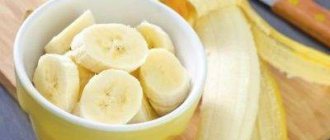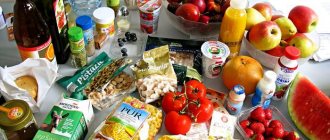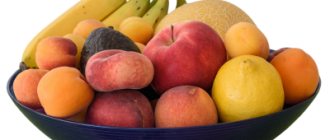Nutritional value, composition and calorie content of bananas
One medium fruit contains about 105 calories, most of which come from carbohydrates.
100 grams of bananas contain (% of the recommended daily intake) ():
- Calorie content: 89 kcal (4%).
- Carbohydrates: 22.8 g (8%).
- Fiber: 2.6 g (10%).
- Fat: 0.3 g (1%).
- Protein: 1.1 g (2%).
- Vitamin C: 8.7 mg (15%).
- Vitamin B6: 0.4 mg (18%).
- Folic acid: 20 mcg (5%).
- Potassium: 358 mg (10%).
- Manganese: 0.3 mg (13%).
- Omega-3 fatty acids: 27 mg.
- Omega-6 fatty acids: 46 mg.
Carbohydrates
Bananas are a rich source of carbohydrates. Unripe bananas contain mainly starch, while ripe ones contain sugar. The carbohydrate composition of bananas changes dramatically during ripening.
The main component of unripe bananas is starch - green bananas contain up to 70-80% starch, in dry weight.
During ripening, starch is converted to sugars and makes up less than 1% when the banana is fully ripe. The most common types of sugar found in ripe bananas are sucrose, fructose and glucose. In ripe bananas, the total sugar content can reach more than 16% of the mass of the fresh fruit ().
Depending on the degree of ripeness, bananas have a relatively low glycemic index of 42-58 (). This is a measure of how quickly carbohydrates in food enter the bloodstream.
Bananas' low glycemic index is due to their high resistant starch and fiber content, which prevent blood sugar levels from rising quickly after eating.
Application in cosmetology
Many cosmetics concerns use banana as a raw material for the production of face, body and hair care products. It is easy to make masks and lotions at home.
Moisturizing mask with banana against acne
Mix ½ ripe banana with 1 tablespoon of unsweetened yogurt or sour cream, add 1 capsule of vitamin E and 1 teaspoon of bran. Mix, apply to face for 20 minutes, rinse with warm water and repeat 2 times a week.
Anti-wrinkle mask with banana peel
Using a spoon, carefully remove the pulp from the banana peel. Carefully break the chicken egg and separate the yolk. Mix in the pulp, stirring thoroughly with a fork. Apply to the neck and skin around the eyes, after 30 minutes, rinse with warm water.
Banana hair rinse
Mix 1 liter of warm water with ripe banana pieces and beat thoroughly with a blender. After shampooing, apply to hair, leave for 5 minutes and rinse.
Advice!
A banana mask helps with sunburn. Place the fruit in the freezer for 20 minutes, cool and beat with a blender or mash thoroughly with a fork. Apply to damaged areas of skin, leave for 30 minutes.
Cellulose
The high proportion of starch in unripe bananas is resistant starch, which, as the name suggests, is resistant to digestion and is therefore a type of fiber.
Resistant starch travels to the large intestine, where it is fermented by bacteria in a process that produces butyrate, a short-chain fatty acid that has beneficial effects on gut health ().
Bananas are also a good source of other types of dietary fiber, such as pectin. Some types of pectin in bananas are water soluble. As bananas ripen, the proportion of water-soluble pectin increases, which is one of the main reasons why these fruits become softer as they ripen ().
Both pectin and resistant starch moderately increase blood sugar levels after meals.
Summary:
Bananas are mainly made up of carbohydrates. Unripe bananas can contain a decent amount of resistant starch, which functions as fiber to promote colon health and healthy blood sugar levels.
Use in cooking
We advise you to look in supermarkets for plantains rather than ordinary bananas. This is a vegetable variety that is used in many countries as our potatoes. The fruits are peeled, then boiled, stewed with meat, made into dough and prepared into a delicious dish - fried banana.
- In Polynesia, a popular dish is masi - canned plantains and breadfruit.
- In Venezuela, they prepare yo-yo - feed bananas are fried with soft sheep cheese.
- In India, boiled banana flowers are used in traditional curry paste.
- In Latin America, unsweetened chips are made from plantains.
- All over the world, bananas are added to smoothies, fruit salads and baking fillings.
- Frozen banana pulp is natural ice cream.
- Microwave bananas topped with banana topping - the easiest dessert in 3 minutes.
Advice!
For vegans and those fasting, it is recommended to replace eggs in baked goods with bananas. 1 medium-sized fruit = 1 chicken egg. Peel the fruit, mash thoroughly with a fork and use as indicated in the recipe.
Vitamins and minerals
Bananas are an important source of several vitamins and minerals, especially potassium, vitamin B6 and vitamin C ().
- Potassium : Bananas are a good source of potassium. A diet high in potassium may lower blood pressure in people with high blood pressure and has a positive effect on the cardiovascular system ().
- Vitamin B6 : Bananas are high in vitamin B6. One medium banana can provide up to 33% of the recommended daily intake of vitamin B6.
- Vitamin C : Like most fruits, bananas are a good source of vitamin C.
Summary:
Bananas contain a number of vitamins and minerals in decent quantities. These include potassium, vitamin B6 and vitamin C.
So what about gas?
From time to time I hear people who buy bananas say that “they are treated with some kind of gas,” which means it’s not mine, it’s still harmful. In fact, this misconception has absolutely no fundamental basis . To prove this, we will have to talk about plant hormones. Let's start from afar.
One of the key aspects of the banana phenomenon is its degree of ripeness. Since it is this factor that affects the taste characteristics. Bananas that are exported are harvested green “starchy” and without noticeable changes in their condition are easily transported around the world in refrigerators at a temperature of +13-15 °C (56.3 and 59.0 °F). At lower temperatures, bananas turn black due to the destruction of the cell walls (which can be observed by keeping them in the refrigerator at 4°C), although the inside of the fruit remains unchanged. By the way, they can remain in this state for quite a long time, until they rot (“never reaching maturity”).
Subscribe to our INSTAGRAM account!
Some national cuisines (Jamaican, for example) use such green bananas as food raw materials with a high starch content, so many suppliers offer “still bananas” to the market, i.e. those on which the gassing procedure has not been carried out.
But we love yellow and sweet bananas, and for this we need to trigger the mechanism of forced ripening. This is done in the country of destination, in special aeration (ripening) chambers. For processing, bananas are transferred from relatively cool storage areas to a heat-insulated aeration chamber, where first the bananas are heated to +18-20 °C, and then the chamber is filled with the so-called. “banana gas” - a mixture of nitrogen (95%) and ethylene (5%).
A daily exposure in a gas atmosphere starts the ripening process, and after storage in a normal atmosphere for three to seven days, the bananas are ready for sale. The degree of ripeness of bananas is controlled by the parameters of aeration and the duration of aging in the warehouse. The picture actually shows instructions for the operator of the ripening chamber (degrees in Fahrenheit, if someone wants to make such a chamber at home, is translated using the formula (Fahrenheit - 32): 1.8 = Celsius).
By the way, a characteristic feature of an unripe banana (in addition to color) is pronounced longitudinal edges (ribs) on the fruit; A ripe banana has an almost circular cross-section, without pronounced edges.
The main component in this entire procedure is ethylene gas. Many people have probably heard/seen about plant growth stimulants (for example, auxins or gibberellins), with the help of which anyone can grow their own miracle fruit at home. This also includes ethylene gas, because it is the simplest representative of plant hormones (yes, plants also have their own hormones).
Phytohormones are low-molecular organic substances produced by plants and having regulatory functions. They act in very low concentrations and cause various physiological and morphological changes in plant parts sensitive to their action.
There is no need to be afraid of ethylene, since it is synthesized by all plants, with the exception of algae, as well as fungi and some bacteria. The rate of ethylene formation in plant tissues averages 5-50 nl/h (g wet weight), and the content is 0.1-2.0 nl/g wet weight. A lot of ethylene accumulates in falling leaves and flowers, and in the nodes of shoots. Ripening fruits have a particularly high ethylene content. For example, in apples its concentration reaches 2500 nl/g wet weight.
Like other phytohormones, ethylene controls many processes in plants, many of which are induced by stress (flooding, cooling or high temperatures, pathogens, drought). That is why ethylene is often called a stress hormone.
The main and only source of ethylene in plants is the amino acid methionine, and plants have a special mechanism for constantly replenishing reserves of this sulfur-containing amino acid (the so-called Young cycle, during which the CH3-S group remaining from methionine after the synthesis of 1-aminocyclopropane-1 -carboxylic acid (ACC - the direct precursor of ethylene), is again used for its formation. When fruits ripen, the enzymes of ethylene synthesis - ACC synthase and ACC oxidase - are activated and as a result of all these processes, the ethylene content in tissues constantly increases.
One of the characteristics of some fruits that ripen faster when treated with ethylene is increased respiration before ripening, called climacteric. In such fruits, increased respiration is followed by a sharp activation of ethylene synthesis. This process occurs in an autocatalytic mode, since it has been established that treatment of fruits with ethylene activates its synthesis and causes an even greater increase in the content of this hormone in tissues during ripening.
Examples of climacteric fruits are apples, pears, plums, bananas, avocados, mangoes, peaches, and tomatoes.
If during the ripening process the intensity of respiration in the tissues does not change, such fruits are called non-climacteric. These include citrus fruits, grapes, cherries, pineapple, strawberries and some others.
Subscribe to our Yandex Zen channel!
You can check this effect by placing ripe fruit in a closed container with unripe fruit. The ethylene released from ripe fruit will be enough to speed up the ripening process in unripe fruit. At the same time, the ripening speed increases several times. Ethylene will have a similar effect on cut flowers and indoor plants.
Therefore, if you do not want your roses to quickly age and wilt, never leave them indoors next to ripe vegetables and fruits.
The ripening mechanism deserves special mention (it is the same for all fruits, not just bananas). For a plant, ripening means the seeds and fruits are ready to spread. During the ripening of fruits, with the help of various enzymes, the breakdown of cell wall elements occurs (pectinase ~~ and pectinesterase ~~ dissolves cell walls and softens the fruit), hydrolysis of starch (amylase converts starch into oligosaccharides), disappearance of organic acids and phenolic compounds, including tannins (hydrolase, for example, hydrolyzes chlorophyll, which is why the skin begins to fade) and the accumulation of sugars. Ethylene, as mentioned earlier, accelerates these processes, so behind the scenes it is also called a maturation hormone.
Sometimes, by the way, it is necessary to slow down the action of ethylene, for example, to preserve ripe fruit longer. For such purposes, another gas is used - methylcyclopropene , which inhibits the production of ethylene and blocks its action.
Other plant compounds
Fruits and vegetables contain numerous types of bioactive plant compounds, and bananas are no exception.
- Dopamine : Is an important neurotransmitter produced in the human brain. However, it is worth understanding that the dopamine present in bananas does not cross the blood-brain barrier to influence mood, but rather acts as a powerful antioxidant ().
- Catechin : Several antioxidant flavonoids are found in bananas, especially catechins (). Catechins have been shown to provide a variety of benefits to the human body, including reducing the risk of cardiovascular disease ().
Summary:
Like other fruits, bananas contain several health-promoting antioxidants that are associated with many health benefits. These include dopamine and catechin.
The benefits of bananas for the human body
Like most natural foods, bananas have many beneficial properties. Here are the benefits of bananas:
Benefits of Bananas for Heart Health
Cardiovascular disease is the most common cause of premature death.
Bananas contain high amounts of potassium, a mineral that promotes heart health and normal blood pressure. One medium banana contains about 0.4 grams of this heart-healthy mineral.
According to a large analysis of many studies, daily intake of 1.3-1.4 g of potassium is associated with a 26% reduction in the risk of developing cardiovascular disease ().
In addition, bananas contain antioxidant flavonoids, which are also associated with a significant reduction in the risk of developing cardiovascular disease ().
Summary:
Bananas may be beneficial for heart health due to the high amount of potassium and antioxidants present in them.
Benefits of bananas for digestive health
Unripe, green bananas contain significant amounts of resistant starch and pectin, which are types of dietary fiber (fiber). Resistant starch and pectins act as prebiotic nutrients that support the growth of beneficial gut bacteria.
They pass into the colon where they are fermented by beneficial bacteria to form butyrate (), a short-chain fatty acid that promotes gut health ().
Summary:
Unripe bananas contain a decent amount of resistant starch, a type of fiber that may promote colon health.
Eating bananas helps increase energy levels
Bananas are a great snack because they provide carbohydrates in the form of instant sugars that your body can use for energy. After exercise, your body uses carbohydrates to refuel and repair muscle fibers that have been broken down.
After sports training, eating bananas supplies the body with sugar molecules that can quickly reach muscle tissue right when they are needed most. This helps quickly restore glucose stores, which is vital for your body to get the energy it needs to build muscle mass and strength.
Bananas are useful either before training (1-1.5 hours before training) or immediately after it, since their consumption provides the body with a sufficient amount of essential carbohydrates and nutrients.
Instead of relying on sugary snacks or sports drinks before or after workouts, or during your midday energy slump, try eating a banana instead. With only 89 calories per 100 grams, bananas are a great pre- or post-workout snack, especially since they are a whole food and contain no artificial ingredients compared to commercially packaged snacks.
Summary:
Thanks to the carbohydrates contained in bananas in the form of instant sugars, eating them before or after a workout, as well as during the midday slump, helps increase energy levels in the body.
Bananas can improve your mood
Bananas contain an amino acid called tryptophan, which facilitates the regulation of serotonin, one of our main “happy hormones” (). Normal levels of serotonin help improve mood and prevent mood disorders, including anxiety and depression.
Eating bananas also provides the body with antioxidants, which help with the release of dopamine in the brain, another mood-boosting hormone ().
Eating bananas regularly can help increase your energy levels, prevent fatigue and maintain a positive outlook.
Summary:
Thanks to tryptophan and dopamine in bananas, their consumption helps improve mood and prevent anxiety and depression.
Benefits of bananas for brain, skin and bones
Eating bananas can benefit your brain, skin, and bones because just one banana provides your body with 16% of the recommended daily intake (RDI) of manganese you need throughout the day.
Plus, bananas are a good source of vitamin C (more than 15% of the RDI), which helps in the production of collagen necessary for the skin.
Manganese is important for many functions in the body, including maintaining healthy skin, maintaining skeletal health, maintaining proper brain function, and reducing free radicals in the body.
Research has shown that manganese can help the brain function normally and prevent diseases such as epilepsy and Parkinson's disease (,).
Some animal studies have shown that low levels of manganese contribute to poor bone health and possibly the development of diseases such as osteoporosis.
The manganese in bananas benefits the health and appearance of your skin by promoting the production of collagen, an important structural component that keeps skin youthful and elastic.
Manganese also has anti-inflammatory and antioxidant properties, which are beneficial for naturally anti-aging as they reduce free radical damage and oxidative stress.
Summary:
Due to the significant amount of manganese and vitamin C contained in bananas, their consumption helps maintain proper brain function and improve skin and bone health. Bananas prevent diseases such as osteoporosis, epilepsy and Parkinson's disease and maintain youthful and elastic skin.
Banana diet for weight loss
Despite the fact that banana is a high-calorie food, it is used for weight loss.
Banana is used for weight loss.
In this case, the property of this fruit is used, such as the ability to quickly saturate and replenish energy. Due to the presence of hard-to-digest dietary fiber, it improves metabolism and removes excess fluid from the body, which promotes weight loss.
In addition, the fruit has a relatively low glycemic index, as a result of which it quickly saturates and suppresses the feeling of hunger for a long time. There is a mono-diet based on the use of these fruits. Its principle is to carry out fasting days, during which you are allowed to consume only 5 banana fruits and 3 tbsp. milk at intervals of 2 hours. You can drink another cup of kefir before bed.
The banana mono-diet is followed for 3 days. In the subsequent time, you should not pounce on food: you should eat in moderation at least until the end of the week.
Harm of bananas to the human body
So, why are bananas harmful?
There are mixed opinions about whether bananas are good for diabetics or not. It is true that bananas contain large amounts of starch and sugar, and therefore can be expected to cause a significant increase in blood sugar levels.
But because of their low glycemic index, moderate consumption of bananas should not raise your blood sugar levels as much as other high-carb foods.
However, diabetics should avoid eating large quantities of well-ripened bananas. Diabetics should always monitor their blood sugar levels after eating foods rich in sugar and carbohydrates.
On the other hand, sometimes people believe that eating bananas is a risk factor for constipation (), while other studies suggest that bananas may have the opposite effect, at least in some people ().
In conclusion, consuming bananas does not seem to have any serious side effects, at least not when consumed in moderation.
Summary:
Bananas are generally considered to be beneficial for human health. However, people with diabetes should avoid eating large quantities of well-ripened bananas.
Application in medicine
Bananas are not used in the pharmaceutical industry, but their beneficial properties are used in folk medicine.
- An infusion of flowers helps with bronchitis and dry cough; it is an excellent expectorant.
- Fresh leaves in many tropical countries are used to treat wounds and abrasions, like our plantain.
- Dried banana roots are added to tea for dysentery and other gastrointestinal disorders.
Medicinal recipes
- For bronchitis, it is recommended to drink a honey-banana drink. Beat the pulp of three fruits in a blender with 500 ml of boiling water, let it brew for 30 minutes. Add 3 tablespoons of honey, drink ½ glass 4 times a day before meals for a week.
- A banana-kefir drink helps with constipation. Beat two ripe bananas with 300 ml of fresh kefir and add 2 tablespoons of oat bran. Drink in the morning on an empty stomach; it is recommended not to eat anything on the day of administration, so that fiber and kefir effectively cleanse the intestinal walls.
- To treat a dry cough, it is recommended to beat the pulp of a ripe banana with 100 ml of freshly squeezed orange juice, add ½ teaspoon of cinnamon and 150 ml of boiling water. Drink three times a day 20 minutes before meals for a week.
Advice!
Don't throw away banana peels! We recommend drying it in the oven, grinding it into powder and adding it to water for flowerpots when watering; this is a natural fertilizer.
Summarize
- Bananas are among the most commonly consumed fruits in the world.
- They consist mostly of carbohydrates and contain decent amounts of several vitamins, minerals and antioxidants.
- Potassium, vitamin C, manganese, catechins and resistant starch are some of the health-promoting nutrients in bananas.
- They can help improve heart, digestive, skin, brain and bone health when consumed regularly as part of a healthy lifestyle.
Tags: Bananas
- Related Posts
- Raisins: benefits and harm for the human body
- Tangerines: beneficial properties and contraindications
- Can you eat kiwi peel?
« Previous entry











